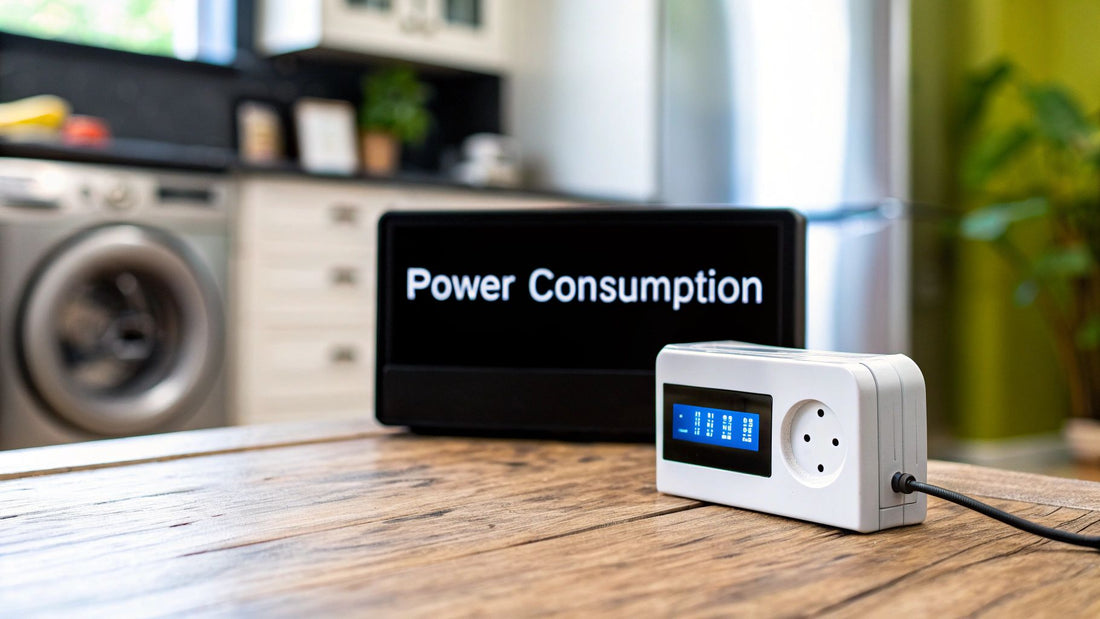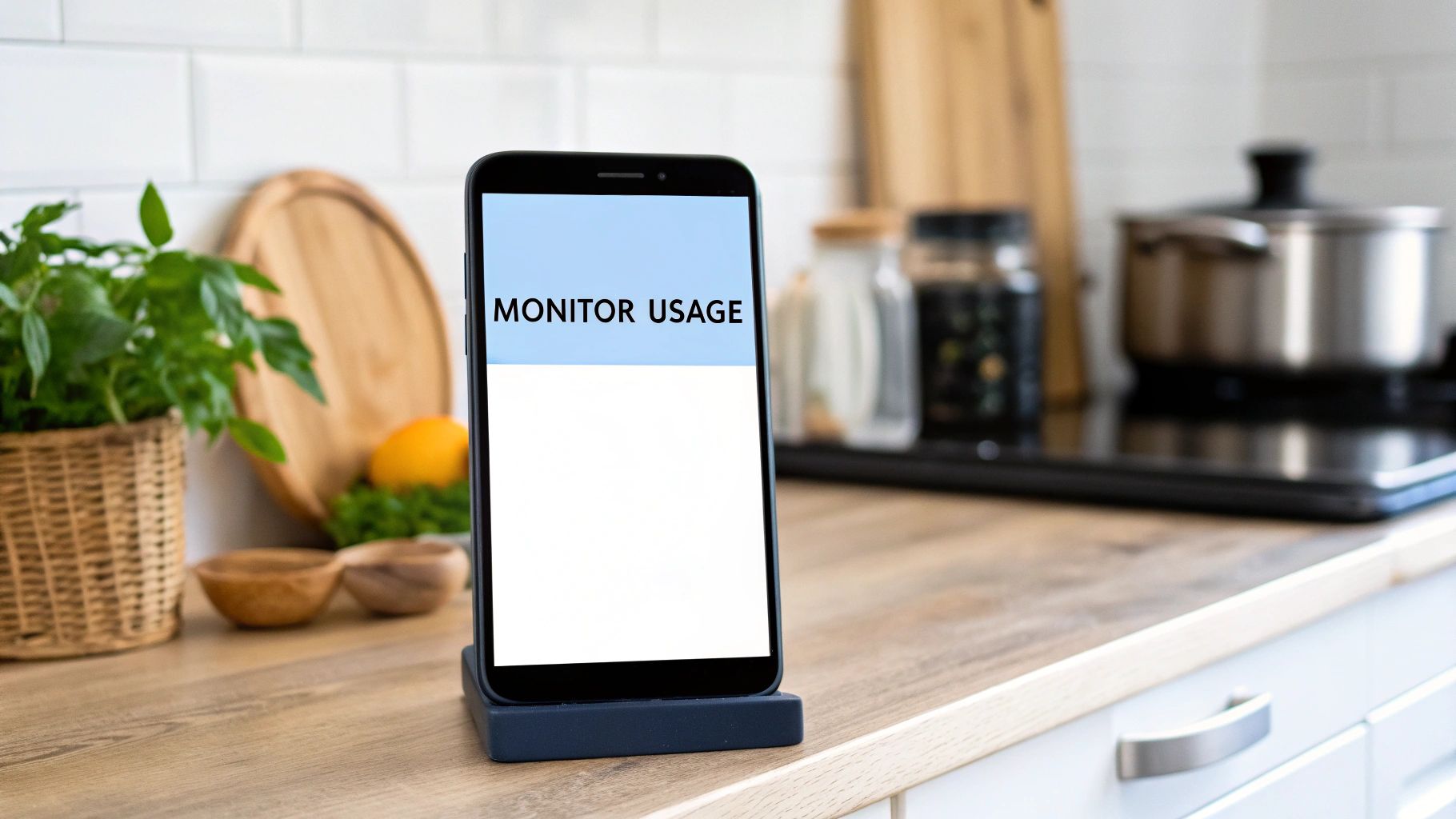
How to Calculate Power Consumption: A Guide for Installers, Developers & Homeowners
Share
Calculating power consumption boils down to a single, critical formula: Power (W) × Time (h) / 1,000 = Energy (kWh). For any professional sizing a solar array or a homeowner trying to lower their utility bill, mastering this calculation is the first step toward making informed, cost-effective energy decisions.
This guide provides an actionable framework for accurately calculating energy use. For installers and developers, this means precise system sizing and quoting. For facility managers, it’s about identifying operational savings. And for homeowners, it’s the key to understanding and controlling your monthly electricity costs. We'll cover the core concepts, provide real-world examples, and show you how to turn this data into a winning energy strategy.
Decoding Your Energy Use
Before you can manage energy costs, you must speak the language. The terms watts, kilowatts (kW), and kilowatt-hours (kWh) are the foundation for every project decision, from sizing a residential backup battery to designing a commercial microgrid.
Here’s a practical breakdown for project stakeholders:
- Watts (W) measure instantaneous power—the rate of energy use at a specific moment. A 1,000-watt microwave is pulling that much power the second it's running. It's the "speed" of your energy consumption.
- Kilowatts (kW) are simply 1,000 watts, a more convenient unit for larger loads like HVAC systems, EV chargers, or commercial equipment.
- Kilowatt-hours (kWh) measure the total energy consumed over time. This is the "distance" you've traveled and the metric your utility uses for billing.
Getting this distinction right is everything. Your electric bill doesn't charge you for the peak power your facility can draw (kW)—though that can trigger separate demand charges—it primarily charges you for the total energy consumed all month (kWh). Once that clicks, you're ready to accurately forecast project costs and identify real opportunities for efficiency.
Why This Calculation Matters Now
Mastering load calculation is more critical today than ever. With global electricity consumption projected to hit 29,000 terawatt-hours (TWh) by 2026, understanding your project's or property's share is essential for financial planning and sustainability.
For professionals, the stakes are even higher. You cannot correctly size a commercial solar array, battery backup system from brands like FranklinWH or BYD, or a standby generator without accurate load calculations. This is a fundamental requirement for meeting NEC standards, ensuring system performance, and delivering a project with a solid ROI. These concepts also tie directly into sizing transformers and generators; for a deeper dive, see our guide on how to convert kVA to kW.
Calculating Energy Use For Any Appliance
Knowing the theory is one thing, but the real power comes from applying it to specific devices. This is where you take control, whether you’re a facility manager pinpointing costs or an installer performing a load analysis for a client.
The process is straightforward: find the power draw, estimate the runtime, and do the math.
First, identify the appliance's wattage (W). This number, typically found on a compliance label near the power cord, tells you its power demand.
If the wattage isn't listed, the label will provide the voltage (V) and amperage (A). Multiply them to find the power in watts:
Voltage (V) x Amps (A) = Watts (W)
A device rated for 120V and 2.5A pulls 300W of power.
Estimating Usage and Running the Numbers
Once you have the wattage, you need a realistic estimate of how many hours the appliance runs each day. Be honest and specific: a coffee maker might run for one hour, but a server rack in a commercial facility pulls power 24/7. The accuracy of your estimate directly impacts the validity of your calculation.
With wattage and daily hours, you can calculate the daily kilowatt-hours (kWh)—the number that drives utility bills.
This flowchart breaks down the simple three-step process.
Converting wattage into kilowatt-hours is the key to aligning your calculations with your power company's billing methodology.
Before we dive into specific examples, this reference table provides ballpark consumption figures for common appliances, using a national average electricity rate of $0.17 per kWh for cost estimates.
Common Appliance Wattage and Estimated Monthly Cost
| Appliance | Typical Wattage (Watts) | Estimated Hours/Day | Estimated Monthly kWh | Estimated Monthly Cost (@$0.17/kWh) |
|---|---|---|---|---|
| LED Light Bulb | 10 W | 8 hours | 2.4 kWh | $0.41 |
| Laptop | 65 W | 8 hours | 15.6 kWh | $2.65 |
| Refrigerator | 200 W | 8 hours (cycling) | 48 kWh | $8.16 |
| Desktop Computer | 250 W | 8 hours | 60 kWh | $10.20 |
| Coffee Maker | 1,200 W | 1 hour | 36 kWh | $6.12 |
| Space Heater | 1,500 W | 4 hours | 180 kWh | $30.60 |
| Commercial Freezer | 3,000 W | 24 hours | 2,160 kWh | $367.20 |
| Level 2 EV Charger | 7,200 W | 4 hours | 864 kWh | $146.88 |
Note: These are estimates. Your actual usage, equipment efficiency, and utility rates will vary.
Real-World Scenarios and Calculations
Let's apply this to common professional and residential scenarios.
Example 1: A Commercial Walk-In Freezer
A restaurant facility manager needs to budget for a new freezer. The spec sheet lists consumption at 3,000 watts. Since it runs continuously, daily usage is 24 hours.
-
Calculation:
(3,000 W x 24 hours) / 1,000 = 72 kWh per day
Example 2: A Home EV Charger
An installer is quoting a Level 2 EV charger that pulls 7,200 watts (7.2 kW). The homeowner expects to charge for four hours nightly.
-
Calculation:
(7,200 W x 4 hours) / 1,000 = 28.8 kWh per charge
Example 3: Sizing a Circuit for a Server Rack
An electrical contractor is wiring a server closet with a total equipment load of 4,800 watts on a 240V circuit. They must determine the amperage to select the correct breaker size per NEC guidelines.
-
Calculation:
4,800 W / 240 V = 20 Amps
This is ground zero for all electrical planning. It dictates breaker sizes, wire gauges, and the feasibility of an off-grid solar system. Understanding how these units relate is critical. For more, see our guide on converting kilowatt-hours to amps.
Choosing the Right Tools for Power Monitoring
Manual calculations provide a solid baseline, but for dynamic, actionable insights, you need the right tools. Modern monitoring hardware eliminates guesswork, providing the precise, real-time data needed to make smarter financial and operational decisions.
For homeowners and facility managers, a simple plug-in energy monitor (or watt meter) is the ideal first step. Devices like the Kill A Watt meter plug in between an appliance and the outlet, measuring its exact power draw. This is the perfect tool for hunting down "energy vampires"—devices that pull standby power—and building an accurate picture of where your energy dollars are going.
From Single Devices to Whole-Building Insights
While tracking one appliance is useful, a whole-building energy monitoring system provides a complete operational view. These systems connect directly to your electrical panel, tracking the entire property's consumption in real-time and sending data to a smartphone app.
This level of detail is a game-changer. You can see the exact energy spike when an HVAC unit kicks on or determine the building's baseload power consumption overnight. This data is essential for justifying efficiency upgrades, managing demand charges, and correctly sizing new equipment. For any renewable energy project, this information is non-negotiable, a topic we cover in our guide to designing an off-grid solar system.
Advanced Tools for Commercial and Utility-Scale Projects
For commercial and industrial projects, the tools become more sophisticated. Advanced Metering Infrastructure (AMI) and smart meters are the industry standard for gathering granular consumption data in short intervals.
Critical Note: This methodology—Energy (kWh) = Power (kW) × Time (h)—is the same one used in large-scale grid management. Utilities rely on AMI, now covering over 50% of U.S. and EU households, to forecast demand and optimize grid stability.
For an EPC or developer, this data is invaluable. It is used to model project ROI, manage demand charges, correctly size multi-megawatt solar and battery storage systems, and ensure compliance with complex utility interconnection and rebate programs. The right tool depends on your goal, from saving a few dollars at home to optimizing a utility-scale asset.
Connecting Kilowatt-Hours to Real-World Costs
Knowing your kilowatt-hour (kWh) usage is only half the battle. The ultimate goal is to connect that number to your bottom line. This is where abstract energy data becomes a tangible dollar figure.
Your utility bill contains the key: your electricity rate, listed as a cost per kWh. This is rarely a simple flat rate. Utilities use different structures to manage grid demand, and understanding yours is critical to unlocking savings.
Decoding Your Utility Rate Structure
You cannot optimize costs without knowing how you are being charged. Most plans fall into one of these categories:
- Tiered Rates: The cost per kWh increases as your consumption crosses certain thresholds. The first "block" of energy is the cheapest.
- Time-of-Use (TOU) Rates: The price of electricity changes based on the time of day. "Peak" hours (e.g., late afternoon) are the most expensive, while "off-peak" hours (e.g., overnight) are the cheapest.
- Demand Charges: A major cost factor for commercial and industrial customers. In addition to paying for total energy (kWh), you are billed for your single highest spike in power usage (kW) during a billing period.
Once you know your rate structure, the math is simple:
Total kWh Usage x Cost Per kWh = Total Electricity Cost
This formula empowers you to move from passively measuring consumption to actively managing expenses.
Putting Rate Knowledge Into Action
Consider a commercial kitchen running an appliance that draws 1,500 watts for eight hours daily. The utility uses a TOU plan where peak power costs $0.25/kWh and off-peak is $0.12/kWh.
Scenario 1: Running During Peak Hours
First, calculate daily kWh: (1,500 W x 8 hours) / 1,000 = 12 kWh.
Running during peak hours costs 12 kWh x $0.25/kWh = $3.00 per day.
Scenario 2: Running During Off-Peak Hours
The energy usage remains 12 kWh.
By shifting operation to off-peak hours, the cost drops to 12 kWh x $0.12/kWh = $1.44 per day.
By simply changing when the appliance runs, the operating cost is cut by over 50%. This same logic applies to scheduling EV charging, industrial processes, and other high-draw equipment. Aligning energy use with your utility's cheapest rates delivers significant savings.
Using Consumption Data to Lower Your Energy Footprint

Once you know how to calculate power consumption, you can make impactful changes. This is where data transforms into lower bills and a smarter energy strategy for everyone from homeowners to utility-scale developers.
Your data tells a story, pointing directly to the biggest opportunities for savings.
Start by hunting down "energy vampires"—devices pulling standby power. Use a plug-in meter to quantify the cost of office equipment, entertainment centers, and chargers left plugged in. Next, use the data to identify low-hanging fruit for upgrades. If an old freezer is a major energy hog, replacing it with a modern ENERGY STAR model is an investment with a clear, measurable payback period. The same logic applies to upgrading lighting to high-efficiency LEDs.
Sizing Systems with Precision
For professionals, accurate load calculations are the foundation of sound system design. They are non-negotiable for correctly sizing solar arrays, battery storage, and backup power systems.
For Installers: Your load analysis dictates the entire bill of materials (BOM). It determines the required inverter capacity, the number of solar modules, and the kWh of battery storage from brands like FranklinWH or BYD needed to meet a client's backup power or self-consumption goals.
For Developers: Commercial load profiles are essential for modeling a project's ROI. Accurate data allows you to size a system to maximize financial returns, factoring in complex utility rates, demand charges, and potential revenue from grid services or incentive programs like the IRA.
From Calculation to Actionable Strategy
Tracking consumption exposes challenges and opportunities. The average U.S. household consumes around 10,500 kWh annually. As global energy demand continues to grow, hitting decarbonization targets remains a challenge. For a deeper analysis, you can review the global energy outlook at RFF.org.
Use your data to build a strategic plan:
- Prioritize Big Wins: Target the largest energy consumers first for the fastest payback.
- Shift Loads: If you have TOU rates, move high-consumption activities like EV charging to off-peak hours.
- Right-Size New Systems: Base all new solar, storage, or generator designs on hard consumption data, not guesswork.
By turning calculations into a data-driven action plan, you can take control of your energy footprint and lock in lower costs for the long term.
Common Questions About Calculating Power Consumption
Even with the right formulas, real-world questions arise. Getting clear answers is key to managing energy with confidence, whether you're a homeowner diagnosing a high bill or a contractor finalizing a system design.
Here are the questions we hear most often.
Why Is My Bill Higher Than My Calculations?
This is the most common question. A discrepancy between your calculations and your utility bill almost always comes down to factors your manual math misses.
- Taxes and Fees: Your bill includes delivery fees, service charges, and local taxes not reflected in your kWh calculation.
- Variable Power Draws: An appliance's wattage label often indicates its maximum draw. A refrigerator compressor, for example, cycles on and off, resulting in a lower average consumption.
- Phantom Loads: "Energy vampires" like TVs, game consoles, and chargers constantly pull standby power, which can add up significantly over a month.
Pro Tip: The best way to measure a single appliance is with a plug-in energy monitor over a full 24-hour cycle. This captures its true consumption pattern and provides a much more accurate cost estimate.
What Is the Difference Between kW and kWh?
Understanding this distinction is fundamental.
- A kilowatt (kW) is a measure of power—the rate of energy use at a given moment (your "speed").
- A kilowatt-hour (kWh) is a measure of energy—the total amount consumed over time (the "distance" traveled).
Your utility primarily bills you for the total "distance" (kWh). However, for many commercial accounts, your peak "speed" (kW) can trigger separate and costly demand charges.
How Do I Calculate Consumption for My Entire Building?
There are two primary methods:
The "bottom-up" approach involves calculating the consumption of every major appliance and system and adding them together. This is labor-intensive but excellent for pinpointing specific energy hogs.
The "top-down" method is simpler. Read your main electric meter, then read it again after a set period (e.g., 24 hours). The difference is your total consumption in kWh. For a more sophisticated approach, a whole-building energy monitor provides this data in real-time.
Ready to turn your energy calculations into a smarter, more efficient electrical system? From initial load analysis to final procurement, Portlandia Electric Supply provides the in-stock inventory, technical expertise, and logistical support to make your project a success. Request a quote today and partner with a team that understands your project's real-world needs.
